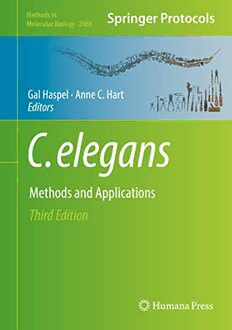Table Of ContentMethods in
Molecular Biology 2468
Gal Haspel · Anne C. Hart
Editors
C. elegans
Methods and Applications
Third Edition
M M B
ETHODS IN OLECULAR IO LO GY
SeriesEditor
JohnM.Walker
School of Lifeand MedicalSciences
University ofHertfordshire
Hatfield, Hertfordshire, UK
Forfurther volumes:
http://www.springer.com/series/7651
For over 35 years, biological scientists have come to rely on the research protocols and
methodologiesinthecriticallyacclaimedMethodsinMolecularBiologyseries.Theserieswas
thefirsttointroducethestep-by-stepprotocolsapproachthathasbecomethestandardinall
biomedicalprotocolpublishing.Eachprotocolisprovidedinreadily-reproduciblestep-by-
step fashion, opening with an introductory overview, a list of the materials and reagents
neededtocompletetheexperiment,andfollowedbyadetailedprocedurethatissupported
with a helpful notes section offering tips and tricks of the trade as well as troubleshooting
advice. These hallmark features were introduced by series editor Dr. John Walker and
constitutethekeyingredientineachandeveryvolumeoftheMethodsinMolecularBiology
series. Tested and trusted, comprehensive and reliable, all protocols from the series are
indexedinPubMed.
C. elegans
Methods and Applications
Third Edition
Edited by
Gal Haspel
Department of Biological Sciences, New Jersey Institute of Technology, Newark, NJ, USA
Anne C. Hart
Department of Neuroscience, Brown University, Providence, RI, USA
Editors
GalHaspel AnneC.Hart
DepartmentofBiologicalSciences DepartmentofNeuroscience
NewJerseyInstituteofTechnology BrownUniversity
Newark,NJ,USA Providence,RI,USA
ISSN1064-3745 ISSN1940-6029 (electronic)
MethodsinMolecularBiology
ISBN978-1-0716-2180-6 ISBN978-1-0716-2181-3 (eBook)
https://doi.org/10.1007/978-1-0716-2181-3
©TheEditor(s)(ifapplicable)andTheAuthor(s),underexclusivelicensetoSpringerScience+BusinessMedia,LLC,part
ofSpringerNature2006,2015,2022
Thisworkissubjecttocopyright.AllrightsaresolelyandexclusivelylicensedbythePublisher,whetherthewholeorpart
of the material is concerned, specifically the rights of translation, reprinting, reuse of illustrations, recitation,
broadcasting,reproductionon microfilmsorinanyotherphysicalway,andtransmissionorinformation storageand
retrieval,electronicadaptation, computersoftware,orbysimilar ordissimilar methodologynow knownorhereafter
developed.
Theuseofgeneraldescriptivenames,registerednames,trademarks,servicemarks,etc.inthispublicationdoesnotimply,
evenintheabsenceofaspecificstatement,thatsuchnamesareexemptfromtherelevantprotectivelawsandregulations
andthereforefreeforgeneraluse.
Thepublisher,theauthorsandtheeditorsaresafetoassumethattheadviceandinformationinthisbookarebelievedto
betrueandaccurateatthedateofpublication.Neitherthepublishernortheauthorsortheeditorsgiveawarranty,
expressedorimplied,withrespecttothematerialcontainedhereinorforanyerrorsoromissionsthatmayhavebeen
made.Thepublisherremainsneutralwithregardtojurisdictionalclaimsinpublishedmapsandinstitutionalaffiliations.
CoverIllustrationCaption:“InstrumentsofDiscovery”,adigitalcollagebyGalHaspel(2021).
ThisHumanaimprintispublishedbytheregisteredcompanySpringerScience+BusinessMedia,LLC,partofSpringer
Nature.
Theregisteredcompanyaddressis:1NewYorkPlaza,NewYork,NY10004,U.S.A.
Preface
“Worms are not model animals; they are pioneer organisms and a discovery mechanism.”
(paraphrasingDr.M.Chalfie#Worm21)
C.elegans,andthecommunityofresearchersusingthispioneerorganism,haveproven
to be a discovery engine for the rules of life, from molecules and genes, through cellular
physiology, metabolism and aging, neurobiology to behavior, individuality and interaction
with the environment. This nematode was also used to pioneer methods that became
common practice for diverse researchers, from fluorescent proteins and optogenetic tools,
to genomic sequencing and editing, confocal microscopy, expansion microscopy, and 3D
reconstructionofneurons,amongmanyothers.
WebelievethatthecollegialspiritoftheC.eleganscommunity,explicitlyenvisionedand
cultivatedasthecommunityexpanded,haspromotedtheseinnovationsanddiscoveries.We
aimtoabidebythisspiritbyeditingthiscollection,whichsharesexperience,knowledge,and
perhapswisdom.
The first two chapters provide practical advice for setting up research programs with
C. elegans, either for a new research group or for a short-term project such as a teaching
laboratory. The following chapters are written in a familiar format that, if successful, will
resembleshadowinganexperiencedresearcherastheyruntheir favorite,well-honedexper-
imental protocol, with a list of materials and equipment to prepare, step-by-step instruc-
tions,andusefulnotes.Somechaptersfromthelasteditionwereupdatedandincludedhere,
whileothersthatdidnotrequireupdatescanbefoundinthatcollection.
Wethankourmentors,mentees,andcollaboratorsforteachinguseverythingweknow.
Newark,NJ,USA GalHaspel
Providence,RI,USA AnneC.Hart
v
Contents
Preface ..................................................................... v
Contributors................................................................. ix
1 StartingaC.elegansResearchLaboratory:PracticalAdvice................... 1
AnneC.HartandHeatherL.Bennett
2 TheBasicsofSettingupSuccessfulTeachingLabsandShort-Term
ProjectswithC.elegans.................................................. 25
ElizabethE.Glater
3 CryopreservationofC.elegansandOtherNematodeswithDimethyl
SulfoxideandTrehalose.................................................. 43
KevinF.O’Connell
4 GeneticMethodsforCellularManipulationinC.elegans .................... 51
MenachemKatz
5 ObservingandQuantifyingFluorescentReporters.......................... 73
SreeparnaPradhanandMichaelHendricks
6 MicrobialRhodopsinOptogeneticTools:ApplicationforAnalyses
ofSynapticTransmissionandofNeuronalNetworkActivity
inBehavior............................................................. 89
AmelieBergs,ThiloHenss,CasparGlock,JatinNagpal,
andAlexanderGottschalk
7 OptogeneticPerturbationofIndividualC.elegansPharyngealNeurons
WhileMonitoringFeedingBehavior ...................................... 117
NicholasF.TrojanowskiandChristopherFang-Yen
8 AntibodyStainingforNematodeswithHeat-inducedAntigenRetrieval
(HIAR)................................................................ 133
CurtisM.Loer
9 ExCel:Super-ResolutionImagingofC.eleganswithExpansion
Microscopy............................................................. 141
Chih-Chieh(Jay)Yu,DanielleM.OrozcoCosio,
andEdwardS.Boyden
10 AFusionPCRMethodforExpressingGeneticToolsinC.elegans............ 205
EduardBokman,YifatEliezer,andAlonZaslaver
11 ApproachesforCRISPR/Cas9GenomeEditinginC.elegans................ 215
CharlotteJ.MartinandJohnA.Calarco
12 TargetedandRandomTransposon-AssistedSingle-CopyTransgene
InsertioninC.elegans................................................... 239
SoniaElMouridiandChristianFrøkjær-Jensen
13 MutationMappingandIdentificationbyWhole-GenomeSequencing......... 257
HaroldE.Smith
vii
viii Contents
14 LipidExtractionandAnalysis............................................. 271
HenryH.HarrisonandJenniferL.Watts
15 IsolatingCaenorhabditiselegansfromtheNaturalHabitat ................... 283
ClotildeGimond,NausicaaPoullet,andChristianBraendle
16 MicrofluidicDevicesforBehavioralAnalysis,Microscopy,andNeuronal
ImaginginCaenorhabditiselegans ........................................ 293
RossC.Lagoy,EricLarsen,DanLawler,HamiltonWhite,
andDirkR.Albrecht
17 NeuronalMicrosurgerywithanYb-DopedFiberFemtosecondLaser ......... 319
MariaB.Harreguy,TracyS.Tran,andGalHaspel
18 AnImagingSystemforMonitoringC.elegansBehaviorandAging ........... 329
MatthewA.ChurginandChristopherFang-Yen
19 MethodsforModulatingandMeasuringNeuromuscularExertion
inC.elegans............................................................ 339
KileyJ.HughesandAndre´sG.Vidal-Gadea
20 RecordingandQuantifyingC.elegansBehavior ............................ 357
NavinPokalaandStevenW.Flavell
21 PrimeronMathematicalModelinginC.elegans............................ 375
AyushRanawadeandErelLevine
Index ...................................................................... 387
Contributors
DIRKR.ALBRECHT • DepartmentofBiomedicalEngineering,WorcesterPolytechnicInstitute,
Worcester,MA,USA;DepartmentofBiologyandBiotechnology,WorcesterPolytechnic
Institute,Worcester,MA,USA
HEATHERL.BENNETT • DepartmentofBiology,TrinityCollege,Hartford,CT,USA
AMELIEBERGS • BuchmannInstituteforMolecularLifeSciences,GoetheUniversity,
Frankfurt,Germany;InstituteofBiophysicalChemistry,GoetheUniversity,Frankfurt,
Germany
EDUARDBOKMAN • DepartmentofGenetics,SilbermanInstituteofLifeScience,EdmondJ.
SafraCampus,TheHebrewUniversityofJerusalem,Jerusalem,Israel
EDWARDS.BOYDEN • McGovern InstituteforBrainResearchandKochInstitute,MIT,
Cambridge,MA,USA;DepartmentofBiologicalEngineering,MIT,Cambridge,MA,
USA;DepartmentofBrainandCognitiveSciences,MIT,Cambridge,MA,USA;Howard
HughesMedicalInstitute,Cambridge,MA,USA;DepartmentofMediaArtsandSciences,
MIT,Cambridge,MA,USA;KLisaYangCenter forBionics,andCenter for
NeurobiologicalEngineering,MIT,Cambridge,MA,USA
CHRISTIAN BRAENDLE • Universite´Coˆted’Azur,CNRS,Inserm,IBV,Nice,France
JOHNA.CALARCO • DepartmentofCellandSystemsBiology,UniversityofToronto,Toronto,
ON,Canada
MATTHEWA.CHURGIN • DepartmentofBioengineering,SchoolofEngineeringandApplied
Science,UniversityofPennsylvania,Philadelphia,PA,USA
SONIAELMOURIDI • BiologicalandEnvironmentalScienceandEngineeringDivision
(BESE),KAUSTEnvironmentalEpigeneticsProgram(KEEP),KingAbdullah
UniversityofScienceandTechnology(KAUST),Thuwal,SaudiArabia
YIFATELIEZER • DepartmentofGenetics,SilbermanInstituteofLifeScience,EdmondJ.
SafraCampus,TheHebrewUniversityofJerusalem,Jerusalem,Israel
CHRISTOPHERFANG-YEN • DepartmentofBioengineering,SchoolofEngineeringand
AppliedScience,UniversityofPennsylvania,Philadelphia,PA,USA;Departmentof
Neuroscience,PerelmanSchoolofMedicine,UniversityofPennsylvania,Philadelphia,PA,
USA
STEVENW.FLAVELL • DepartmentofBrain&CognitiveSciences,PicowerInstitutefor
Learning&Memory,MassachusettsInstituteofTechnology,Cambridge,MA,USA
CHRISTIAN FRØKJÆR-JENSEN • BiologicalandEnvironmentalScienceandEngineering
Division(BESE),KAUSTEnvironmentalEpigeneticsProgram(KEEP),KingAbdullah
UniversityofScienceandTechnology(KAUST),Thuwal,SaudiArabia
CLOTILDEGIMOND • Universite´Coˆted’Azur,CNRS,Inserm,IBV,Nice,France
ELIZABETHE.GLATER • PomonaCollege,Claremont,CA,USA
CASPARGLOCK • BuchmannInstituteforMolecularLifeSciences,GoetheUniversity,
Frankfurt,Germany;InstituteofBiophysicalChemistry,GoetheUniversity,Frankfurt,
Germany;Max-Planck-InstituteforBrainResearch,Frankfurt,Germany
ALEXANDERGOTTSCHALK • BuchmannInstituteforMolecularLifeSciences,Goethe
University,Frankfurt,Germany;InstituteofBiophysicalChemistry,GoetheUniversity,
Frankfurt,Germany
ix
x Contributors
MARIAB.HARREGUY • FederatedDepartmentofBiologicalSciences,NewJerseyInstituteof
TechnologyandRutgersUniversity,Newark,NJ,USA
HENRYH.HARRISON • SchoolofMolecularBiosciences,WashingtonStateUniversity,
Pullman,WA,USA
ANNEC.HART • DepartmentofNeuroscienceandRobertJ.andNancyD.CarneyInstitute
forBrainScience,BrownUniversity,Providence,RI,USA
GALHASPEL • FederatedDepartmentofBiologicalSciences,NewJerseyInstituteof
TechnologyandRutgersUniversity,Newark,NJ,USA
MICHAELHENDRICKS • DepartmentofBiology,McGillUniversity,Montreal,QC,Canada
THILO HENSS • BuchmannInstituteforMolecularLifeSciences,GoetheUniversity,
Frankfurt,Germany;InstituteofBiophysicalChemistry,GoetheUniversity,Frankfurt,
Germany
KILEYJ.HUGHES • SchoolofBiologicalSciences,IllinoisStateUniversity,Normal,IL,USA
MENACHEMKATZ • DepartmentofBiology,Technion-IsraelInstituteofTechnology,Haifa,
Israel
ROSSC.LAGOY • DepartmentofBiomedicalEngineering,WorcesterPolytechnicInstitute,
Worcester,MA,USA
ERICLARSEN • DepartmentofBiomedicalEngineering,WorcesterPolytechnicInstitute,
Worcester,MA,USA
DANLAWLER • DepartmentofBiomedicalEngineering,WorcesterPolytechnicInstitute,
Worcester,MA,USA
ERELLEVINE • DepartmentofBioengineering,NortheasternUniversity,Boston,MA,USA
CURTISM.LOER • FletcherJonesProfessorofBiology,DepartmentofBiology,Universityof
SanDiego,SanDiego,CA,USA
CHARLOTTEJ.MARTIN • DepartmentofCellandSystemsBiology,UniversityofToronto,
Toronto,ON,Canada
JATINNAGPAL • BuchmannInstituteforMolecularLifeSciences,GoetheUniversity,
Frankfurt,Germany;InstituteofBiophysicalChemistry,GoetheUniversity,Frankfurt,
Germany;APCMicrobiomeIreland,UniversityCollegeCork,Cork,Ireland
KEVIN F.O’CONNELL • LaboratoryofBiochemistryandGenetics,NationalInstituteof
Diabetes&DigestiveandKidneyDiseases,Bethesda,MD,USA
DANIELLEM.OROZCOCOSIO • McGovernInstituteforBrainResearchandKochInstitute,
MIT,Cambridge,MA,USA;DepartmentofBrainandCognitiveSciences,MIT,
Cambridge,MA,USA
NAVINPOKALA • DepartmentofBiologicalandChemicalSciences,TheobaldScienceCenter,
NewYorkInstituteofTechnology,OldWestbury,NY,USA
NAUSICAAPOULLET • Universite´Coˆted’Azur,CNRS,Inserm,IBV,Nice,France;URZ,
INRAE,Petit-Bourg(Guadeloupe),France
SREEPARNAPRADHAN • PicowerInstituteforLearningandMemory,MassachusettsInstitute
ofTechnology,Cambridge,MA,USA
AYUSH RANAWADE • DepartmentofBioengineering,NortheasternUniversity,Boston,MA,
USA
HAROLDE.SMITH • NationalInstituteofDiabetesandDigestiveandKidneyDiseases,
NationalInstitutesofHealth,Bethesda,MD,USA
TRACY S.TRAN • FederatedDepartmentofBiologicalSciences,NewJerseyInstituteof
TechnologyandRutgersUniversity,Newark,NJ,USA

